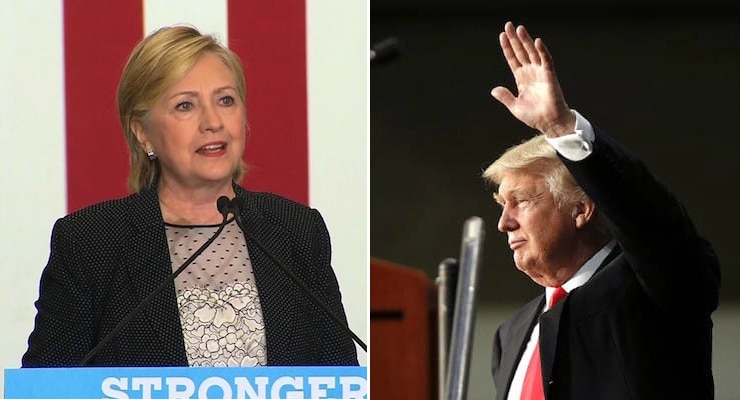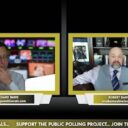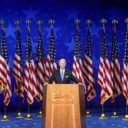

(Editor’s Note: I’ve been waiting for two things to happen before writing this article–for the media expectation game to get as dramatically one-sided as it is now–and, for what I saw in North Carolina last night. The candidate who won the Republican primary started acting like a general election candidate. Like him, love him or hate him, Donald Trump is a unique candidate.
As I’ve said since the primary, Mr. Trump can either win big or lose big because he breaks convention wisdom. His support is attitudinal, not constrained to traditional theories and demographic patterns. But it’s up to him whether or not he takes advantage of that unique political advantage.)
To be clear, we view Hillary Clinton as the favorite in the fall for the first time this cycle, but despite media-fueled expectations and assuming his pivot doesn’t turn into a 15-minute break before again getting off message, Donald Trump can still defeat Hillary Clinton in November and become the next President of the United States.
The Polls
Let’s take the number one argument, which basically holds that no candidate down in the polls by this margin at this time has gone on to win in November. On Bill O’Reilly Thursday night, former Bush White House press secretary Dana Perino said “the state of the GOP race right now is really bad.”
“No candidate who has ever been this far behind in August has gone on to win,” she added.
I applaud Ms. Perino for calling the race how she sees it. I want to believe the Trump-Bush feud has nothing to do with it, though I’m sure many of you will point out she had no problem”un-skewing the polls” for Gov. Mitt Romney. Nevertheless, I’m going to stick to the fact that the assertion she made, which has been echoed repeatedly this week, is flimsy at best.
Analysis comparing polling data from past elections is the same as comparing apples to oranges. I understand we simply have no choice but to do so, but statistically speaking, you cannot make any comparison between Gallup polling and do so with any degree of certainty. There are many more pollsters in 2016 than in 1948 and they are generally less accurate.
Even if we compared historical Gallup polling data to the umpteen polls released in 2016, the assumption really doesn’t hold up to scrutiny. In 1948, Thomas Dewey had an even larger lead than Mrs. Clinton has now over Mr. Trump, a lead that continued right up until Election Day. Yet, the polls were off by a whopping 10-point spread.
| Month | Harry Truman (D) % | Thomas Dewey (R) % | Henry Wallace (Progressive) % | Strom Thurmond (Dixiecrat) % |
|---|---|---|---|---|
| August/September | 37% | 48% | 4% | 2% |
| 36% | 49% | 5% | 3% | |
| 39% | 47% | 3% | 2% | |
| 39% | 47% | 3% | 2% | |
| 40% | 46% | 4% | 2% | |
| October/November | 45% | 50% | 4% | 2% |
| Actual result | 50% | 45% | 2% | 2% |
| Difference between actual result and final poll | +5% | -5% | -2% | 0% |
In 1960, Richard Nixon began the month of August with roughly the same lead Mrs. Clinton now holds over Mr. Trump, yet he lost it and the election. Worth noting, it was Mr. Nixon who was running as the third-term predecessor like Mrs. Clinton. If polling data and the historical record tell us anything, it’s that the Republican candidate can win if he rights the ship before or shortly after Labor Day.
| Month | John F. Kennedy (D) % | Richard Nixon (R) % |
|---|---|---|
| August/September | 44% | 50% |
| 47% | 47% | |
| 48% | 47% | |
| 46% | 47% | |
| October/November | 49% | 46% |
| 49% | 45% | |
| 51% | 49% | |
| Actual result | 50% | 50% |
| Difference between actual result and final poll | -1% | +1% |
We could do this all day by picking a month and trying to find a correlation, which is why our research generally holds to the wisdom Labor Day is the beginning of the critical period. What we are hearing are cherry-picked talking points pretending to be data sets, which is what Karl Rove did in 2012.
In an interview with Megyn Kelly, Mr. Rove touted Gov. Romney’s lead in the Gallup poll, claiming that “no candidate who has led in mid-October with 50 percent or more in the likely voter poll has ever gone on to lose.“ Gov. Romney also held a 7-point lead in the Investors Business Daily Tracking poll and by 4 points in the Pew Research poll.
How did that turn out? Coincidentally, Mr. Trump trails in the Pew poll by the exact same margin.
In 1988, George H. W. Bush, another third-term incumbent, was down by a significant double-digit margin leading up to the month of August and only closed the gap enough to trail by roughly 7 points (basically where we are now) by the end of the month. Soon-to-be President George H. W. Bush didn’t even take the lead until almost mid-September. In this example, we’re going to show the month of July just to make a point.
| Month | George H. W. Bush (R) % | Michael Dukakis (D) % |
|---|---|---|
| July | 41% | 47% |
| 37% | 54% | |
| August | 42% | 49% |
| September | 49% | 41% |
| 47% | 42% | |
| October | 50% | 40% |
| November | 56% | 44% |
| Actual result | 53% | 46% |
| Difference between actual result and final poll | -3% | +2% |
As you can see, Gov. Michael Dukakis actually widened his lead over then-Vice President Bush in the month of August. He enjoyed a margin far larger than Mrs. Clinton holds over Mr. Trump.
In 2000, when another third-term incumbent was running against an insurgent Republican (he was also America First before Neocon), he was down by large margins in the month of August and, though he went on to lose, the polls were grossly inaccurate. In fact, to this very day many analysts believe he didn’t lose. I’m not one of them, but you get the point. Let’s again go back to August, but notice how large Vice President Al Gore led then-Gov. George Bush in September and October.
| Month | George W. Bush (R) % | Al Gore (D) % | Ralph Nader (Green) % |
|---|---|---|---|
| April | 47% | 41% | 4% |
| May | |||
| August | 54% | 37% | 4% |
| 55% | 39% | 2% | |
| 46% | 47% | 3% | |
| 46% | 45% | 3% | |
| September | 44% | 47% | 3% |
| 46% | 45% | 2% | |
| 42% | 49% | 3% | |
| 41% | 49% | 4% | |
| 42% | 49% | 2% | |
| 41% | 49% | 3% | |
| 44% | 48% | 2% | |
| 41% | 51% | 3% | |
| 42% | 50% | 2% | |
| 47% | 44% | 2% | |
| 46% | 44% | 2% | |
| 46% | 44% | 3% | |
| 45% | 45% | 4% | |
| October | 41% | 49% | 2% |
| 40% | 51% | 2% | |
| 48% | 41% | 4% | |
| 50% | 42% | 4% | |
| 45% | 45% | 2% | |
| 45% | 45% | 3% | |
| 48% | 43% | 2% | |
| 47% | 44% | 3% | |
| 51% | 40% | 4% | |
| 44% | 46% | 4% | |
| 49% | 42% | 3% | |
| 52% | 39% | 4% | |
| 49% | 42% | 3% | |
| 47% | 44% | 3% | |
| 47% | 43% | 4% | |
| November | 47% | 43% | 4% |
| 48% | 46% | 4% | |
| Actual result | 48%^ | 48%^^ | 3% |
| Difference between actual result and final poll | 0% | +2% | -1% |
Mr. Bush was actually trailing Mr. Gore by a larger margin than seen here in several other polls. But you get the drift. The claim made by Ms. Perino and others doesn’t really hold up to scrutiny when historical data is examined carefully and it definitely doesn’t hold up when you compare elections that are at least more similiar than others, which brings me to my next point.
Volatility & Fundamentals
I thought we learned during the primary that this election isn’t like other elections, but I guess I was wrong. Likability, trustworthiness and competence are turning out to play a larger role than anticipated and potentially why this election season has an unusually high number of persuadable and undecided voters. America is simply too polarized to see a Johnson- or Nixon- or Reagan-like landslide. What I think is really happening is that Mr. Trump has begun what was inevitable–a political realignment.
The question is whether he can complete it before voters take to the polls. George W. Bush did with the old Perot Coalition in 2000, but it was in the making long before he decided to run for president. Win or lose, the Republican Party, much to the chagrin of the old guard, will never be the same after Mr. Trump. But if he wants to win he has to do something every other successful presidential candidate has done–convince voters you have the temperament to do the job.
In truth, considering the spending and coverage disparity in this election, I’d expect to see Mrs. Clinton with a much larger lead than she has now. Mr. Trump is just now getting on the airwaves, while Mrs. Clinton has been hammering away at him for weeks and spent millions upon millions of dollars. The reason she isn’t is because his message is a winning, more potent message–outsider change vs. the corrupt status quo–and voters just need to feel comfortable with the messenger.
There is also the chance of an October surprise, which we have basically been promised by WikiLeaks founder Julian Assange. The Federal Bureau of Investigation continues to investigate the Clinton Foundation and is actively trying to circumvent the Obama Justice Department in D.C. in order to move forward with the U.S. District Attorney in New York. I personally believe Mrs. Clinton is above the law, but that doesn’t prohibit damaging information indicting her at the ballot box.
A Warning About Polls & “Forecasters”
Only a few weeks before the election, The Fix at The Washington Post–the same publication who has yet to discipline one of their reporters for writing whatever the DNC told him to write–proclaimed “Democrats now have a 51 percent chance of holding the Senate.” To describe the change in probability, Mr. Cillizza ironically said it was “huge,” and fueled by polling numbers for senators who went on to lose.
Let’s look at one of those races.
Chris Cillizza, citing all the “major” polls, “reported” the Washington Post “Election Lab” on August 27 concluded “Sen. Mark Udall (D) had a 64 percent chance of winning.” In late September, when Mr. Cillizza was writing his update, he “reported” Sen. Udall “has a 94 percent chance.”
Well, Sen. Udall is now Mr. Udall and Rep. Cory Gardner is now Sen. Cory Gardner, despite his rhetoric on immigration, abortion and hailing from Colorado, the only battleground state where the share of the Hispanic vote is more than the national average. As I explained after the election, Sen. Gardner won because he won, not because Hispanics didn’t show up to the polls.
Nate Silver, who gave Mr. Trump a 5% chance of winning the Republican nomination, is wrong more than he’s right. I dealt with that recently and don’t feel like repeating myself. But they were all wrong in 2014 and have yet to adequately explain the disparity between their rantings and reality.
Do you know who wasn’t? Take a guess.






